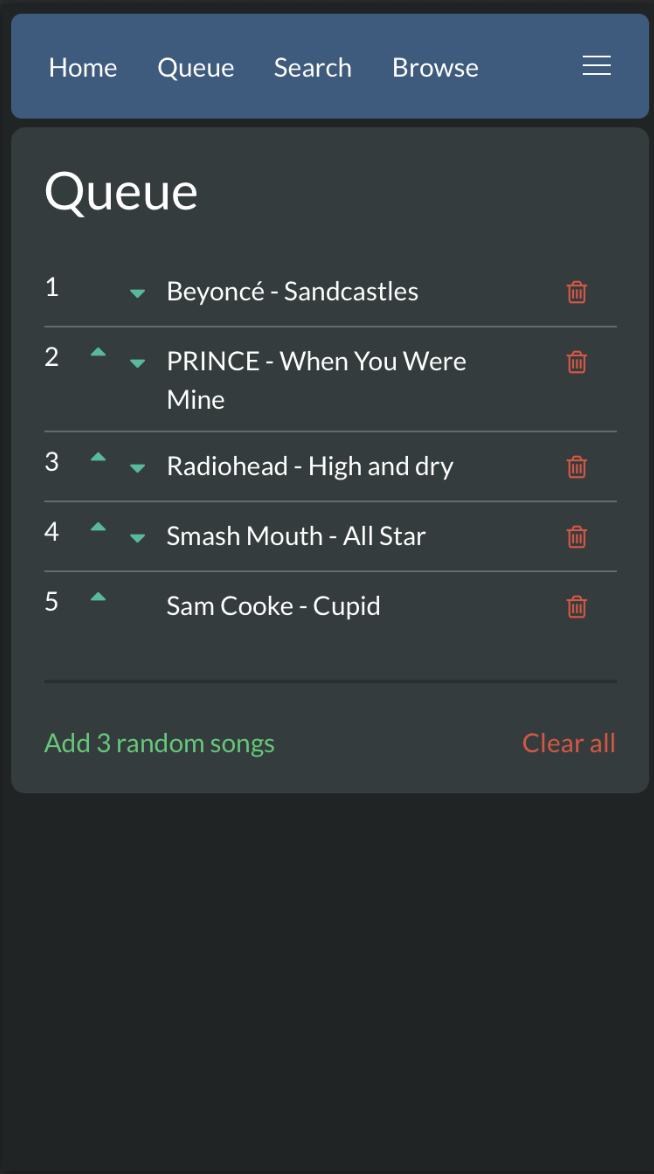PiKaraoke is a "KTV"-style karaoke song search and queueing system. It connects to your TV, and shows a QR code for computers and smartphones to connect to a web interface. From there, multiple users can seamlessly search your local track library, queue up songs, add an endless selection of new karaoke tracks from YouTube, and more. Works on Raspberry Pi, OSX, Windows, and Linux!
Pikaraoke is independently developed and maintained. If you want to support this project with a little monetary tip, it's much appreciated:
| Feature | Description |
|---|---|
| Web Interface | Multiple users can queue tracks from their smartphones |
| Player/Splash Screen | Connection QR code and song queue metadata |
| Searching/Browsing | Search and rowse a local song library |
| Adding New Songs | Add new songs from Youtube |
| mp3 + cdg Support | CDG file support, supports compressed .zip bundles |
| Playback Controls | Pause, Skip, Restart, and volume control |
| Queue Management | Manage the song queue and change the order |
| Key Change / Pitch Shifting | Adjust the pitch of songs |
| File Management | Advanced editing of downloaded file names |
| Admin Mode | Lock down features with admin mode |
| Headless Mode | Run a dedicated pikaraoke server and stream to remote browser |
- Raspberry Pi
- Requires a Raspberry Pi Model 3 or higher
- Bookworm Desktop OS required for standalone/headed mode
- For Pi 3: overclocking is recommended for smoother playback
- OSX
- Windows
- Linux
- Python 3.9 or greater (You can check your current version by running
python --version): Python downloads - FFmpeg: FFmpeg downloads
- Chrome browser (recommended, though Safari and Firefox will work with the
--complete-transcode-before-playoption)
sudo apt-get install ffmpeg -y
sudo apt-get install chromium-browser -y
sudo apt-get install chromium-chromedriver -y
Chromium/Chromdriver is optional if you're running with the --headless option.
Globally or within a virtual env:
# Install pikaraoke from PyPi
pip install pikaraokeNote: Some OS install pip as pip3. if you did not use a venv, you may need to add the --break-system-packages parameter to ignore the warning and install pikaraoke and its dependencies globally. You may experience package conflicts if you have other python programs installed.
Pikaraoke is now installed in the $PATH with the command line interface pikaraoke. Start by calling the pikaraoke command.
pikaraokeThis will start pikaraoke in headed mode, and open Chrome browser with the splash screen. You can then connect to the QR code via your mobile device and start downloading and queueing songs.
Virtual env users: note that if you close your terminal between launches, you'll need to reactivate your venv before running pikaraoke.
To upgrade to the latest version of pikaraoke, run:
pip install pikaraoke --upgradeSee the help command pikaraoke --help for available options.
For Docker users, you can get going with one command. The deployed images includes everything you need to run in headless mode:
docker run vicwomg/pikaraoke:latestFor more information, see official Dockerhub repo
The Pikaraoke project utilizes Poetry for dependency management and local development.
- Install poetry: Poetry
- Git clone this repo
From the pikaraoke directory:
# install dependencies
poetry install# Run pikaraoke from the local codebase
poetry run pikaraokeIf you don't want to install poetry, you can alternately install pikaraoke directly from the source code root:
pip install .See the Pikaraoke development guide for more details.
See the TROUBLESHOOTING wiki for help with issues.
There are also some great guides on the wiki to running pikaraoke in all manner of bizarre places including Android, Chromecast, and embedded TVs!







